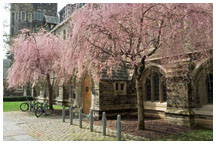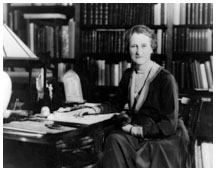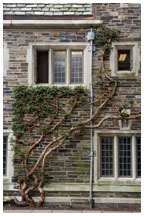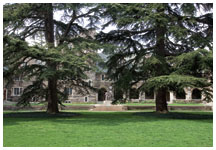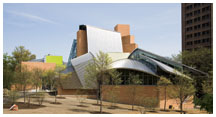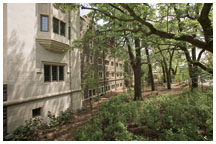
June 11, 2008: Features
Landscape architect
Beatrix Farrand “liked spring colors, because the students
would be here to see them.”
Farrand chose a pair of Japanese flowering cherry trees to weep over the entryway at Henry Hall. These two trees, above, planted around 2000, were chosen to look like trees selected by Farrand and shown in a photo taken in the 1920s.
Undated photo of Beatrix Jones Farrand in the library at Reef Point, her family’s home at Bar Harbor, Maine. More than 90 varieties of shrubs, trees, and vines eventually were espaliered to walls around campus.
Above, a Japanese climbing hydrangea, a creeping vine with its own tendrils that adhere to the walls, at Foulke Hall. These plants were trained to grow up the walls in the mid- to late-1920s, when Beatrix Farrand was landscaping that part of campus with her head gardener, James Clark. When the vines became very heavy, probably in the 1950s and ’60s, they were espaliered to the wall with wire and steel screw eyes, which can still be seen on many of the dormitory walls.
The Graduate College remains the best-preserved example of Farrand’s work on campus. ... The site also provides one of the clearest insights into Farrand’s philosophy of landscaping and its relation to education. These two cedars of Lebanon, above, were grown from seeds collected by Harvard University in the Cilician Mountains in southern Turkey, and were gifts to Dean Andrew Fleming West 1874 from Charles Sargent Sprague, who mentored Farrand. West, whose statue is in the background, had the trees planted in 1913 in the Quad at the Graduate College. “Today,
the campus architecture is more diverse. But we still use plantings
to enhance the architecture without taking away from it.”
An oval-roofed reading room in the new Lewis Science Library, top, known by architect Frank Gehry as the “tree-house,” looks over the tops of native sassafras and sweet bay magnolias. The trees were chosen because of their magnificent fall colors of golden orange and yellow. Winter king hawthorn trees were planted next to the front entrance on Ivy Lane; the small flowering trees will develop bright red berries in the fall. Bottom, the landscaping at Whitman College enhances the woodland setting chosen by architect Demetri Porphyrios *80. |
Growing
the campus
How Princeton preserves its “lazy beauty”
By Mark F. Bernstein ’83
All photos by Ricardo Barros (ricardobarros.com)
For the record
A feature in the June 11, 2008, issue of PAW on landscape architect Beatrix Farrand
misstated the name of Charles Sprague Sargent, her mentor and the founder of
the Arnold Arboretum in Boston.
Two rows of Japanese yews line the approach to the center of campus from the Dinky station. The trees were planted in the 1920s by Beatrix Jones Farrand, the great landscape architect; eight decades later, on an afternoon in early April, W. Barksdale Maynard ’88, a lecturer in art and archaeology, leads his class on a field trip to admire her handiwork. This path once was part of the train line, which terminated in the middle of what is now Lockhart Courtyard. When the station was moved to its current location in 1918, the walkway was created as a campus entry, and Farrand’s plantings enriched the design.
“Look at how those yews have been clipped,” Maynard gestures to students in his class on “Architecture of Princeton University,” pointing out how the trees are clipped back so as not to obscure the stately dormitories or the majestic view of Blair Arch in the distance. “It’s to prepare you for the order of the campus.”
That order presents itself once one passes through the iron gate that leads into the Henry-1901 Courtyard. Wisteria vines, their white and purple blossoms not yet open, climb the walls. On the east side of Henry Hall, a pair of pink weeping cherry trees frame the center entry while climbing hydrangea are trained against the stone — “stapled to it,” in Maynard’s words. Across the courtyard, orange-berried pyracantha decorates Laughlin Hall near pink and white saucer magnolias Farrand planted in 1922. “Farrand liked spring colors,” Maynard explains, “because the students would be here to see them.”
Meanwhile, on the other side of campus, forklifts move sassafras trees into place outside the new Frank Gehry-designed Lewis Science Library on Washington Road. Gehry’s building includes a glass “tree-house room” on the top floor; James Consolloy, the University’s manager for grounds and buildings maintenance, working with Michael Van Valkenburgh, Princeton’s consulting landscape architect, decided that people should be able to look out those windows onto the tops of trees, so it was necessary to plant species that would not grow to more than about three stories tall.
“We had to look all over hell to find [sassafras trees],” says Consolloy, who eventually located them close to home, at a New Jersey nursery. In consultation with Gehry, the landscapers introduced sassafras trees because of their height and because their orange leaves in fall would provide a Princeton touch. The surrounding area on Ivy Lane was to be planted with taller, fringe trees such as Virginia magnolia, sweet bay, and hawthorn.
Few places are prettier than Princeton’s campus in the spring, and that distinctive, parklike character — that sense of order Maynard refers to, which F. Scott Fitzgerald ’17 called Princeton’s “lazy beauty” — is colored largely by Farrand’s palette. Preserving the legacy of the woman who was Princeton’s landscape architect for almost 30 years — and interpreting it for the future — has become a challenge. Princeton itself has changed: The nearly 500-acre campus now sprawls down to Lake Carnegie, the student body has swelled, and so have the demands placed on facilities. The climate has changed, too: Summers are hotter and drier, winters are warmer, and the cost of everything from cultivating plants to transporting them has increased. Add to that the growing concern about pursuing ecologically sustainable forms of development, and modern landscapers face challenges Farrand did not.
Landscape architecture, no less than the architecture of bricks and mortar, is highlighted in the 10-year campus plan unveiled last winter, which aims to balance expansion with a sense of order. At 180 pages, the plan covers everything from new buildings to parking to rainwater runoff and landscaping. (A summary brochure was mailed to all alumni in January; a complete copy of the report can be found on the Internet at http://www.princeton.edu/campusplan/).
In a 1926 article for PAW, Farrand expressed a theory of landscaping that shaped most of the upper campus. “Although the Princeton University plantings have been primarily designed as appropriate settings to the various buildings, there has also been a second object,” she wrote. “Surroundings of fitness and beauty in the familiar scene unconsciously become part of daily life and stimulate latent sensitiveness to artistic expressions. ... [T]he gardening organization at the University is trying its best to make the dwellers in and around the campus demand beauty in their daily life as part of their right and as essential to their development.”
Though couched in modern report-speak, the new campus plan expresses something of the same ambition: “to accommodate growth on the diminishing available land on campus in an integrated and holistic way that respects and reinforces Princeton’s defining characteristics as a university and a community.” It lists five guiding principles: to preserve and maintain a pedestrian-oriented campus, preserve Princeton’s park-like setting, maintain existing campus neighborhoods while promoting a sense of community, develop in an environmentally sustainable manner, and sustain strong community relations.
For almost a century, Princeton had no landscaping plan at all, although the front green of Nassau Hall is believed to be the inspiration for the use of the word “campus” to describe college grounds. In the mid-19th century, President James McCosh hired Donald G. Mitchell, a novelist and farmer who had published a treatise on landscape gardening, to oversee development of the entire college, creating Princeton on the model of an “English gentleman’s park,” with open lawns and trees laid out informally, rather than geometrically.
Farrand was hired in 1912 to landscape the newly built Graduate College, which had been designed by Ralph Adams Cram after the historic fight between then-University President Woodrow Wilson 1879 and Dean Andrew Fleming West 1874 over where to put it. Then called Beatrix Jones, she had been born in 1872 into New York society and shaped by Victorian propriety and early feminism. Novelist Henry James (who called her “Trix”) was a family friend, and from an early age she shared an interest in gardening with her aunt, the novelist Edith Wharton.
Gardening, though an appropriate hobby, was not an acceptable professional occupation for a well-bred young woman. What turned Farrand to that path was a meeting in 1892 with Charles Sargent Sprague, whose wife was a friend of Farrand’s mother. Sprague had founded the Arnold Arboretum in Boston and was then considered the dean of American horticulture. Recognizing Farrand’s talent, Sprague encouraged her to live with his family and study in his office. At his instigation, she also traveled widely to observe the great private and public gardens of Europe. Although the Jones family disapproved of her wish to pursue landscaping professionally, Beatrix’s uncle, John Lambert Cadwalader, saw in her an “indomitable will” and argued, “Let her be a gardener or, for that matter, anything she wants to be. What she wishes to do will be well done.”
Farrand started her own business when she was only 23, working out of a room on the top floor of her mother’s Manhattan brownstone. She began by designing gardens for other wealthy families, including the Rockefellers and Lodges, and in 1899 became a founding member — the only woman — of the American Society of Landscape Architects. In 1912, when Princeton was looking for someone to landscape the Graduate College, Sprague recommended his protégée to Dean West, who hired her at her usual rate of $50 per day.
Farrand, the landscaper, butted heads almost immediately with Cram, the architect. According to Ann Waldron, who wrote about Farrand for PAW in 1986, Cram thought the road Farrand laid out to connect the main campus to the Graduate College was too winding and had too many trees and shrubs massed along its borders. Farrand refused to back down, and ultimately the dispute was referred to President John Grier Hibben 1882 and two prominent trustees. They split the difference, straightening Farrand’s road but keeping her plantings.
The Graduate College remains the best-preserved example of Farrand’s work on campus, especially the access road, the two inner quadrangles, and the Wyman House garden, all of which still contain many of Farrand’s original plantings, including two huge cedars of Lebanon in the Old Quadrangle that Sprague gave to West as a gift. The site also provides one of the clearest insights into Farrand’s philosophy of landscaping and its relation to education.
In her 1926 PAW article, Farrand wrote, “As the large buildings are so dignified in character and so large in size, the plantings should be kept simple in all respects,” eschewing what she called “pettiness of detail.” As she wrote in a letter to Oberlin College, another client, “A campus is a place for trees and grass, nothing more. And shrubs, but not in thickets.” Farrand chose plants that would bloom in spring or fall, to be enjoyed by students. She favored deciduous trees over evergreens, “for the reason that trees that shed their leaves give shade when shade is required and do not occupy as much ground space as properly grown evergreens.”
Acutely sensitive to aesthetics, Farrand continued, “Within the quadrangle only, creepers and wall shrubs should be used, as freestanding shrubs would tend to destroy the impression of quiet which the buildings themselves give.” She also “discouraged the miscellaneous plantations unconnected with architectural lines.” When she could not get wall plants, she trained shrubs such as forsythia and even trees such as tulip magnolias to climb the walls using hooks and wire in a technique known as espalier. More than 90 varieties of shrubs, trees, and vines eventually were espaliered to walls around campus.
Like Frank Lloyd Wright in architecture, Farrand — who called herself a “landscape gardener” — was a follower of the Arts and Crafts movement of the early 20th century that emphasized the relationship between buildings and their natural surroundings. As Susan C. Jennings wrote in The Vistas of Princeton, “Landscaping, Farrand thought, should not impose a design upon space but should shape it using indigenous materials.” To this end, Farrand developed her own nursery on Faculty Road, which enabled her to use plantings grown in the same local soil in which they would eventually be planted. Consolloy still uses Farrand’s nursery as a staging area for large campus landscaping projects.
Farrand’s work at the Graduate College was so well received that in 1915 she was appointed Princeton’s consulting landscape architect, a post that gave her equal rank with Cram, the University’s consulting architect. Working with the same distinctive palette of trees and espaliered shrubs and vines, her designs covered the main campus, from McCarter Theatre to Prospect Garden and Holder to Pyne Hall, where she ingeniously persuaded a southern magnolia to grow by planting it over a steam tunnel.
Shortly after Princeton hired her for the Graduate College, Beatrix Jones married Max Farrand 1892, a Yale history professor. Although, as The New York Times slyly put it in an 1899 profile, “she belongs to a social circle from which the workers of the world do not so often come,” Farrand and her husband pursued the modern lifestyle of a two-career couple. Speaking of the path she had not taken, Farrand said in another interview, “Society, yes, it is very agreeable. ... But to live for it and in it entirely. Oh, never. This is different. It is work — hard work and at the same time it is perpetual pleasure. With this grand art of mine, I do not envy the greatest painter, or sculptor, or poet that lived. It seems to me that all arts are combined in this.” But Farrand did have to navigate the sexism of her time. Trustee Bayard Henry 1876 disparaged her as “Trixie the bush woman.” When working at Yale, she had to insist that her checks be made out professionally, with her full name, rather than to “Mrs. Farrand.”
Over the next three decades, Farrand would return to Princeton several times a year for inspection tours. She also worked for several other colleges, including Yale, Oberlin, Vassar, Hamilton, and the University of Chicago, as well as at numerous private and public gardens, including the Dumbarton Oaks estate in Washington and at the White House, on a garden commissioned by President Wilson. She continued working almost until her death in 1959.
In addition to her living memorials at Princeton, Farrand is honored by a small bench outside the University Chapel that is inscribed: “Her love of beauty and order is everywhere visible in what she planted for our delight.”
Farrand’s association with Princeton ended in 1943, and the position of a consulting landscape architect was discontinued in the 1960s. For almost four decades thereafter, each new construction project was landscaped idiosyncratically, without any coordination with the rest of the campus. Then, in 2000, buoyed by the success of landscaping work at McCosh Court and on the approach to Prospect House, the University considered other projects and needed someone to figure out how all the pieces would fit together. Princeton hired Quennell Rothschild & Partners, LLP to develop a five-year landscaping plan for refreshing the core campus. The firm also oversaw landscaping for a number of new projects, including the Genomics Institute and Scudder Plaza.
Van Valkenburgh was chosen in 2005 to be the Univers-ity’s new consulting landscape architect, while Lynden Miller of Public Garden Design was retained as consulting gardening architect, responsible for the campus’s 17 gardens. Landscaping plans for all projects are now reviewed by a coordinating committee, which provides the oversight needed because of the different architectural styles on campus, ranging from the classic simplicity of Demetri Porphyrios *80’s Whitman College to the futuristic fantasy of Gehry’s Lewis Science Library.
The plan is comprehensive, aiming to preserve and restore older landscaping while adapting and integrating new areas. Farrand’s successors pay homage to Arts and Crafts principles but often execute them differently. “Landscaping should be supportive of the environment for thinking and recreation,” says Dan Casey, the University’s coordinating architect. “There should be a quiet simplicity and a graceful serenity to outdoor spaces. Plantings should reinforce the overall design rather than shout for attention. ... It will always be important to be able to go outside and stretch out on the grass or throw a Frisbee.”
Global warming has raised soil temperatures, enabling different plant species to thrive and giving modern landscapers the ability to paint from a broader horticultural palette. A southern willow oak now grows along the Ellipse walk, along with water oaks, which are native to Georgia and the Carolinas. Crepe myrtles are coming into use for the first time at Princeton, and metasequoias (dawn redwoods), which are native to the Sichuan-Hubei region of China, have been planted at Whitman College.
But climate change also presents problems. Lynden Miller reports that campus gardens are using fewer annuals and more perennial plants, such as hostas, bleeding hearts, and salvia, which will require less water, along with new, low-maintenance rose hybrids. Lawns gradually are being replanted with a tall turf fescue that Consolloy says can better tolerate hot, dry weather.
Landscaping costs are rising rapidly. Freight charges have nearly doubled over the last few years, and plant costs have risen by more than 30 percent because of higher prices for fuel, propagation, and transport. Where Farrand grew most of her plants from seeds, Consolloy says he grows more from plugs or seedlings, reducing the amount of time in which they must be heated and watered in University greenhouses. Princeton is beginning to grind its own mulch, and Van Valkenburgh has been working to develop a new type of manufactured soil for use around trees and in courtyards that will better promote plant growth and withstand compaction from heavy foot traffic.
The University’s sustainability plan, announced in February, contemplates a number of changes to landscaping practices. Portions of Butler College and the new building for operations research and financial engineering will have the first “true green” roofs, topped by soil and vegetation to reduce heating and cooling loads and reduce storm water runoff. Rainwater gradients outside the new chemistry building, which is scheduled to be completed in 2010, will filter silt and pollution from surface runoff water before discharging it into the streams that feed Lake Carnegie, a practice that will minimize erosion of the stream beds. Newly designed pavements will help direct rainwater runoff into the root zones of surrounding trees. A huge underground cistern beneath the planned Butler College amphitheater will collect rainwater, which can be pumped back out for irrigation when needed — a modern updating of similar irrigation cisterns Farrand once installed in Holder Courtyard and Cuyler Terrace.
In much new construction on the southern part of campus, landscaping is driven by changes in topography as well as taste. The historic campus, Casey points out, was built on mostly level ground, while new development leads down the long slope toward Lake Carnegie, occupying land that until recently was forest. The new plan, Casey says, “honors the early topography of the south campus” by introducing more trees along the creek beds that run beside Washington Road and Elm Drive. Much of the resulting landscape will be more “forest-like,” with nature paths, and there will be a “measured contrast between the woodland landscape south of the Ellipse and the more tailored spaces to the north,” he says.
In the modern aesthetic, majestic is out; natural is in. Van Valkenburgh calls espalier the “caviar” of landscape architecture; a technique too expensive and labor-intensive to be practical on a large scale. Nevertheless, Farrand’s techniques are being adapted where appropriate: Whitman College, which echoes the collegiate gothic architecture of the old campus, is being landscaped in the Farrand style, with espaliered hydrangeas and climbing Boston ivy. But the other side of Whitman, facing the New South administration building, is landscaped with more than 175 new trees and hundreds of shrubs to create a more natural setting.
Butler College is particularly important from a landscaping perspective, because it sits in the middle of campus. “To the north,” the plan says, “the historic campus alongside Nassau Street is structured primarily by buildings, while to the south, the campus areas adjacent to Lake Carnegie are structured primarily by the woodland landscape.” The Butler area can help serve as a more clearly defined bridge between the two areas, tying the upper campus to the new buildings below it. Lourie-Love Walk, which will link the Ellipse with Wilcox Hall in Butler, will be lined with upright beech trees that recall Farrand’s yew-lined path from the Dinky station.
The campus plan envisions a rough division of the campus into five neighborhoods: arts and transit, natural sciences, Ivy Lane and Western Way, Prospect Avenue and William Street, and the old core campus. To link those neighborhoods, several long pathways are being developed and expanded. Shapiro Walk “will be taken to a whole new level,” Van Valkenburgh says, with trees and an “early-spring palette” of plantings, with the aim of creating a “pedestrian highway” running more or less uninterrupted from University Place to the Engineering Quad. Plans also include expanding the broad diagonal pathway running roughly from Alexander Hall to the Frist Campus Center. To the east of Washington Road and south of Prospect Avenue, the plan envisions developing new pathways to tie this area to the rest of campus and improve the flow of pedestrian traffic.
Although the new campus plan will preserve Farrand’s historic landscapes, only about half of her work on campus remains. Some plantings died off due to neglect and others, such as the forsythia at Holder Hall, have been lost to construction and building maintenance. Much of Farrand’s climbing ivy at the Graduate College and elsewhere was removed because of concerns about its effect on the masonry. Maynard hopes that in the coming years Farrand’s handiwork will be maintained with as much historical accuracy as possible. “As they are greening the campus,” he says, “I would like to see a very deliberate attempt to put her landscapes back.”
To some extent, today’s planners share that desire. “Whenever I walk through campus, I often think of what her plan would be,” Consolloy says of Farrand. “But you have to remember that the campus is different now, too. There’s a different flow, a different concentration.” Casey notes that today’s University landscapers still follow Farrand’s principles. “She was very sensitive to the relationship between building and site, and used landscaping to provide continuity and cohesiveness between buildings,” he says. “Today, the campus architecture is more diverse. But we still use plantings to enhance the architecture without taking away from it.”
In Van Valkenburgh’s view, Princeton’s campus enjoys a “unique
humanness of scale. There’s an elegance to it, an unfolding openness
that’s hard to beat.” The goal of modern landscape architects,
he says, is not so much trying to replicate the historical landscape,
which is impossible with bigger buildings in a different natural setting.
Rather, the goal is to find the right complement to it, he says: “The
master plan is about bolstering that landscape and finding new landscapes
that keep the same spirit.” ![]()
Mark F. Bernstein ’83 is PAW’s senior writer.

